There are 4 stages to disc injury. Disc injuries are commonly misdiagnosed or under diagnosed. The result of this misdiagnosis is long term worsening of the condition.
Stage 1 – Disc swelling/bulging – Can also be referred to as degeneration. Disc swelling and degeneration can result from wear and tear, aging or trauma. This condition often goes undiagnosed because it will usually resolve itself if the person removes the irritant. It is common for x-rays (which do not show disc swelling) to show “nothing is wrong”. It is also common for people to be told they have a “weak core” and need to do abdominal exercises. This misunderstanding to the true nature of the problem exposes the patient to a lifetime of chronic and recurring lower back pain. If treated properly chronic pain can be avoided.

disc swelling can put pressure on your nerves
Stage 2 – Disc Protrusion – Can also be called a prolapsed. A disc protrusion results from repetitive movements such as repeated bending and twisting or can result from a specific moment in time trauma. This injury will usually cause nerve pain that will radiate in a very specific pattern into your thigh and possibly all the way to your foot. X-rays are not useful in helping to diagnose the severity of the protrusion but MRI’s are. If treated properly the protrusion can be reduced and the associated pain eliminated but if left unchecked or treated improperly the patient can and will progress to stage 3.
Stage 3 – Disc Herniation – A disc herniation is the area between a disc protrusion and extrusion. It is a severely debilitating lower back injury that causes nerve pain in very specific pain patterns. These patterns are predictable and reproducible if tested properly. X-rays are useless in the diagnosis of a disc herniation. MRI can be useful in diagnosing the severity of the disc herniation and helping the doctor and patient decide on a proper course of treatment whether that be conservative or surgical.
Stage 4 – Disc Extrusion – This is a severe condition that usually results from years of the person suffering from repeated bouts of lower back pain. A typical patient will present with an antalgic lean, pain radiating down their leg and a history of progressive lower back pain. A disc extrusion is often likened to squeezing the jelly out of a jelly doughnut. This condition is not reversible and is usually severely debilitating and limits the patient’s ability to function normally.

The disc material can be squeezed into the spinal canal and cause severe pain
How do you accurately Diagnose Lower Back Disc Injuries?
The most important way to diagnose lower back disc conditions is to LISTEN to the patient’s history and description of their symptoms. Secondly a thorough orthopedic assessment should be performed. These orthopedic tests are commonly taught worldwide in medical schools, chiropractic schools and physical therapy colleges. These tests allow the doctor to differentiate where the pain is coming from by stressing various tissues and nerves.
Seated Leg Raise

Seated Leg Raise
Supine Straight Leg Raise
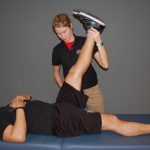
same as seated leg raise but lying down
Slumps
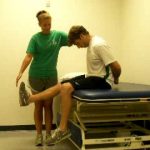
stretches the nerves
Femoral Nerve Stretch test
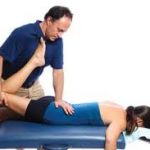
stretches the femoral nerve
Kemp’s Test
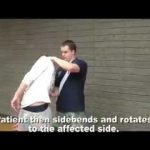
can cause local pain or nerve pain
Piriformis Test

stretches the glute medius and piriformis
Range of Motion Testing
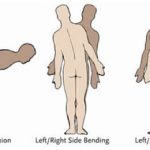
flexion, extension, lateral bending, rotation
How do you effectively treat Lower Back Disc Injuries?
Once a proper diagnosis is achieved an effective treatment plan is put in place that meets specific criteria. It must be reasonable and practical, not worsen the patient’s condition and must result in resolution of the patient’s symptoms. The first thing that is necessary is to remove the irritant. If you are suffering from lower back pain and you are continuously doing something or some activity that is either causing it or aggravating it will never get better!
Step 1: Remove the irritant(s)
The next most important thing to do as the doctor is to establish WHY the patient is suffering from the disc pain. One patient may have disc swelling because of muscle weakness or imbalance while another patient may be suffering from disc pain due to misalignment of their spine or pelvis while another may have disc pain due to a traumatic injury. These 3 patient examples would all be treated separately and distinctly.
Step 2: Find the cause and remedy it.
Treatments for lower back pain due to disc injuries range from conservative to surgery. Surgery should only be used in severe cases that do not respond to conservative measures. Conservative treatments for disc injuries include chiropractic adjustments, modalities such as ultrasound, traction, strengthening exercises and home exercises such as stretching and foam roller. When all of these treatments are combined we find the effects to be magnified and are able to help many patients with lower back disc injuries recover quickly. Unfortunately many clinics ONLY provide one of the interventions causing the person to recover slowly or even worsen and progress to a higher stage disc injury.
Chiropractic Adjustments/Spinal Manipulation

gentle chiropractic adjustments align the spine
Therapeutic Modalities – Ultrasound, Electrical Stimulation, and massage are all examples of therapeutic modalities.
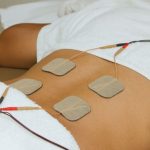
Traction/Decompression – Inversion tables, lying lumbar traction units and expensive decompression centers are all examples of traction.

20-40 degrees of inversion is all that is necessary
Rehabilitative/Strengthening Exercises – Exercises that promote strength and movement of the spine and core muscles are known to help with lower back pain. In our clinic we teach the patient what to do, email them a YouTube instructional video and have them perform the exercises at home or their gym. Paying someone to watch you perform exercises is not the best use of your hard earned time and money.
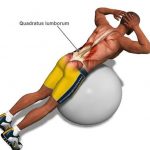
lumbar extension exercises can be very helpful
Home exercises, stretching, foam roller routines
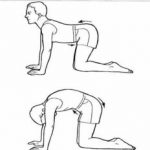
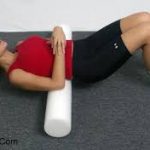
At San Diego Sports Injury and Running Institute we have found that spending the extra time to arrive at an accurate diagnosis is paramount. We then spend the needed time treating the patient correctly and providing the necessary treatments. Patients are also instructed on how to properly care for their condition at home.
To schedule an appointment with Dr. Allen D.C. call 858-268-8525
